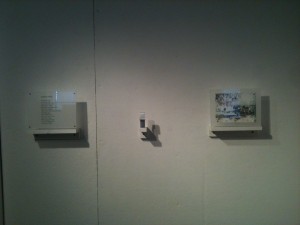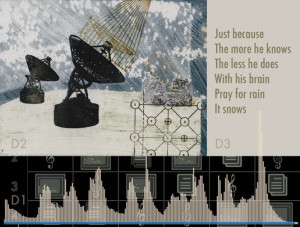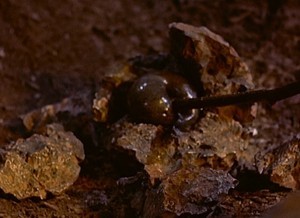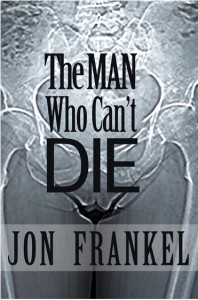Jon Frankel's Blog, page 13
December 9, 2016
A POEM ABOUT A DOOR
6:59
6:59 and I’m still thinking about the door
On State Street with the flaking paint
On either side between the hinge there lies
Truth to be decided, lived and elided
Framed by eroded brick the living have glided
By going in to bed and out to work like flies
On a screen on a hot summer day the sainted
Odor of garbage in the alley behind the store
Syncopated by the afternoon guided
Down the sidewalk dead and in disguise
To the blistered surface the grain faint
Beneath old varnish and beyond, no more
December 2, 2016
DRIVEWAY DREAMS
DRIVEWAY DREAMS
Static in the attic room.
The cherry stripped of leaves
Unlit strands of spherical lamps draped
Like pearls on the reaching branches.
Birds drop from the sky to eat.
Fly off, fly off. I cough. The street
Stanches the air, wet crepe
Cleaves to the moon.
November 22, 2016
sonnet
SONNET
I don’t know where I am; it’s dark
And quiet like a page full of voices
Printed on the blank walls of the stall
Midair, beneath the earth marked by a cairn
Or the Halls of Thetis in a wavering light.
Everywhere I have been is gone from mind.
The silent letters chatter with flags
They cross their arms and march hey ho
The chamber of the day giving way
To night’s myriad potters patting
In multifarious cells and corridors
Connected obliquely with one node
Gone, one place missing
In the interruption of dreams.
November 5, 2016
AIRPORT ODE
Blind correspondents meet to grill
Inane candidates about their beliefs
Sun through the high airport windows
Planes the poly fibre carpet and a man
With an alarming scoliosis stares
At the arrival and departure screen
His wheeled suitcase parked behind him
The bare brown arms of a fidgeting woman
In faded jeans lift and fall the crinkling
Of a plastic bag of our essential stuff
Asteroidal chemicals, space metal genius
Titanium knees unsettle the machine
A full body scan, feet up in the stirrups
Raise your hands above your head
And hold the pose for 3 seconds unless
The authorities call for a pat down
As they did with big woman in skintight
White with no discernible panty line
And a bold camel toe for the glove to explore
I wonder what a dental dam feels like
And who would invent such a thing
They are at gate 77 going to Honolulu
They haven’t a clue about Trump I guess
Or they would stay with free why fie
Or Why Fly? Because I would be normal,
The formal heart declares, and the corner
Of the eye notes bare legs striding and hats
Hiding the unauthored thoughts of fear
The unsorted and out of sorted and aborted
Mewlings and the hat trick and clap trap
Silver slippers, grey sandals, worn Roebucks
Albino deer came up with the hard hat
Boarding the worlds most frightening light
The manful and ancient Hasid on his way
The grim tanned Chinese man and the flat
Top guzzle throated man with a grip
High black boots jeans and sunglasses
Of Malibu bunions parked on her bounteous
Black curls and a man bun double chin
Wattle shack ass shaker shapes and sculpts
The burning birthmarks carved in his face
A general calm prevails among hamsters
The wheels on the trunks go round and round
Pot bellies and red faces and precarious
Coffee cups warming their hands
It’s hard to believe we all fuck and shit
Everyone dreams comes out of mothers
Food may be fleeting and time a darling
And the clear clouds conceal as a wind
The thoughts that frill and flip beneath
Grim smiles and determined hoofing
But it is assumed that suspended
In the upended mind are boggling
Toggling desires and dense fretworks
Of memory, symphonies played by baroque
Orchestras on electric instruments
Picking out the first and last from the many
Or making many fewer with the end
And the beginning markers my friend
It is almost time for lunch and I have a hunch
It will be expensive, wrapped in plastic,
And inadequate but rich with microbes
Best confined to the lower bowel of browsing
Ungulates and ignorant birds in boxes
The great unwashed arriving on shores
Of stainless steel counters and hairnetted
Workers load bread with meat and cheese
And squirt Sriracha mayonnaise squiggles
Down the middle the cheddar cheese smile
Of turkey sandwiches there will be constipation
I’m bound to believe if the explosive opposite
Doesn’t occur there was a time when I shit
In airplane toilets as a child no flight was complete
The air sucking noise of the blue swirl into the belly
Of the hold below and I always ate every scrap
Of Salisbury steak, carrots, peas and mashed potatoes
And as a young teen I frequently joined the solo
Mile High Club masturbating with compulsive
Vigor to the sound of the stewardesses banging
Metal coffee pots and ice on the cart jerking
Into the aisle their harassed faces tanned
Smiles strained as the cigarette smoke filled
The light in the windows complimentary drinks
Jostle with the little liquor bottles emptied
By the men in suits over ice a quick martini
And a nap, jokes about air sickness bags,
I’m looking for some good cleavage
But I come up dry as only old ladies
Have the décolletage of the 1950s a rack
To pose against the cloud wracks swagging
Yes a good balcony of browned boobs
Would be tough to beat where are the gamy girls
When you need them perfuming the air
With their night sweat and toothpaste and hair gel
Avoid delays big black glasses broad brimmed hats
Crackers and papers clutched racing to the gate
October 27, 2016
TWO GREAT BOOKS
I’ve read two great books recently. They are God’s Middle Finger by Richard Grant, and the other is The Warren, By Brian Evenson. Reviews follow (the God’s Middle Finger piece appears on Whiskey Tit in my piece on October reading, and both of these are on goodreads).
WARREN is a new SF novella by horror/fantasy writer Brian Evenson. At 90 pages it is an ideal length and remarkable for its concision. The story is simple: an entity X awakens in a body with other entities and tries to determine what its ontological status is. It does so by questioning ‘the screen’. X and X’s fellow minds are in a place called the Warren. There is another entity, Horak outside of the warren. X asks the screen, “How long has it been since a person left the warren and how long did he survive?” Like all good machines the screen replies with a question of its own: “Query: what do you mean by person?” X turns the question around and the screen answers, Bipedal, an individual thought process enmeshed in a body, procreated through the fertilization of an ovum by a sperm and its subsequent development in a womb.” Only the first criterion is relevant. What follows is a puzzle of consciousness, and a mystery as to what the warren is, who Horak is, and who the other entities are. Evenson is a philosopher but he handles these questions and attendant paradoxes with the style, emotion and humor of a novelist. I’ve read one other book by him, The Open Curtain, a story that might be about a reincarnated serial murderer or about a schizophrenic. Evenson famously is an apostate Mormon and in that book he reveals forbidden Mormon ceremonies as a parting kick. Like Philip K. Dick he is absorbed in epistemological and ontological questions, the blurring of madness and mysticism. He has a novelist’s instinct for the emotions provoked by these questions, not the answers. Unlike Philip K. Dick he has a strong, coherent and disciplined narrative drive. There are no wasted words here and it is not at all a sterile philosophical puzzle but rather a touching search for identity and rueful recognition of the inevitability of death and the ultimate failure of absolute knowledge. Horak and X are melancholic prisoners of decisions made decades earlier, trapped in a poisoned world. One bleeds blood, the other a viscous yellow substance. They are equally convinced of their own reality. The reader quietly claps for the performance in a dark room with a comfortable chair.
I just finished the kind of book I devour with burning eyes and a dry throat, God’s Middle Finger, Into the Lawless Heart of the Sierra Madre, by Richard Grant. Grant is an English travel writer, a grand thing to be, and he sets off for dangerous situations ill prepared with tremendous cynicism, self-irony and energy. He wants to explore the Sierra Madre region of Mexico, a region of wild mountains, forests and canyons cut off from the rest of Mexico, with a long tradition of hiding outlaws and bandits and a culture based on an insane overdevelopment of Macho Honor. Since the 1980s the drug business has defined life for the ranchers, farmers and peasants there. The army and police are concerned exclusively with stealing drugs or extorting money and many are employed by the narcos as enforcers. Scattered in the area are Mormons, various indigenous groups, 3rd generation exiles from the US, well-meaning development people, and eccentrics. The violence is mind boggling as is the beauty. There are touristed areas, but Grant is determined to visit villages notorious for murder, following in the footsteps of the great explorer anthropologist Carl Lumholtz. And this is the true danger of a book like this: Carl Lumholtz spent 5 years traveling the Sierra Madre and living among the Tarahumara, an indigenous people who have survived despite extremely brutal circumstances, and wrote a two volume book about it called Unknown Mexico. Grant infects the reader, or at least the susceptible reader with a desire to read these books, if not to set off immediately for the Sierra Madre. Unknown Mexico is not out of print, but even the Oxford paperback is expensive and the original edition, gorgeous, and HEAVY (one is sitting on my desk right now, and it is the heaviest book for its size I have ever held), sells for about $350. It is very hard to resist reading these volumes. Grant travels by horse, with mules on narrow mountain passes, in pickup trucks and jeeps. The automotive figures heavily in the book, as do heroin, cocaine, beer, bootleg tequila, weed, AK47s. There are times when it reads like Blood Meridian minus the baroque prose. The book reinforces stereotypes about Mexican violence I suppose, but it doesn’t portray the entire nation and all of its people in this way. Many of the people he meets are appalled by the violence of the Sierra Madre and attribute it to a localized and virulent form of machismo that fused with the drug business. The book is hilarious, self-deprecatory, charming, and brilliantly written.
October 14, 2016
WRESTLING
Wrestling
It was bright in the shade and wind
Contested with the sun. As they vied
All day long I couldn’t decide;
Nothing made up my mind
And nothing is the bride
The other of my kind.
October 13, 2016
Nobel Prize!
When I heard Bob Dylan’s name on the news this morning I briefly thought he had died. What a relief and surprise and joy to learn that he had won the Nobel Prize in Literature! Only rarely do I give a damn about the winner. But Dylan deserves it and this is great for the poetry world, which has ignored Dylan, and Dylan’s lyrical, prophetic mode for decades. I have always thought and said that he is the greatest, and most important poet of the second half of the 20th century. This was in opposition to what I had been taught, that he was not a poet because his writing depended on the music to be good, that it doesn’t read well on the page. This is only true if free verse and various other types of modernist technique define what poetry is. Dylan fits in perfectly well, in fact, is a star, in the tradition of English poetry going back to the days of Chaucer. Wyatt and Campion both composed lyrics that are read silently today. Music, dance and poetry have always been closely linked. Dylan’s genius is wayward, antithetical and anti-authoritarian as so much genuine genius is. He has written hundreds of songs. But his songs were the first truly serious lyrics in pop music. Perhaps there were others who wrote sophisticated lyrics, and there were ballads and protest songs that poetically addressed the crisis of the soul on earth, but Dylan pulled it all together. Soul music, blues, tin pan alley, Hank Williams, Woody Guthrie, he knew it all. But he seems to be as steeped in the bible, TS Eliot, Allen Ginsberg, Rimbaud, Dante, Baudelaire, Shakespeare, Blake and Yeats as he was in roots music. It was the radio and the book shelf coming together in the mind and soul of an artist at a time when culture and society were in revolt. By combining the Romantic inward gaze, the prophetic tradition and the social he expresses a range of thought and feeling that are astonishing compared to the work of most if not all contemporary poets, who often seem more concerned with trivialities of aesthetics and careerism. Like all good American artists he is also part PT Barnum and part Lenny Bruce. His best work is harrowing because it plumbs paranoia, apocalyptic fear, and absurdist, surreal joking. He is a savage clown, he is a seer, he is a song and dance man. And he refuses to be pinned down to any of these. His work and his personality are famously protean and obscure and yet, at age 21 he wrote Blowing in the Wind, an anthem to the thirst for freedom, and quoted many years later by an American president (Jimmy Carter). Dylan deserves this award, yes. And so do the rest of us. In a day of shitty, horrifying news, a time that has exhausted absurdism and surrealism, when an evil asshole is running for President and a third of the people think that’s great, how wonderful to be reminded that in times even darker than these art could be entertaining, profound and relevant, and eventually, RECOGNIZED.
October 6, 2016
36 TRANSITIONS OPENS FRIDAY OCTOBER 7TH
Hello, everyone. If you are in Ithaca tomorrow (Friday, October 7th), please come to the Ink Shop for the opening reception of 36 TRANSITIONS, a collaborative, multi-media installation created by Craig Mains, Billy Cote and me.
36 TRANSITIONS
Craig Mains got the idea for 36 Transitions after the opening of his show Time, Manner, Place in 2015. Billy Cote had created a musical installation to accompany the photographs. I was at the opening both to see Craig’s photographs and to hear Billy’s music. We spent some time talking and touring the studio space. Craig was considering creating visual work to accompany Billy’s Music for a future project. Later, he thought to expand the collaboration of print work and music to include text, imagined a six-by-six grid. Each box in the grid is a piece of music, text or an image created in response to the one preceding it. There would be six series of six pieces each. We discussed the project and agreed to spend a year working through the sequences and called it 36 Transitions.
Although we had agreed upon a title, 36 Transitions, in our emails and file names we would sometimes inadvertently refer to 36 Transmissions or 36 Translations. Was this an interpretive process, a reaction, or an attempt to reproduce the prior work in a different medium? How literal is the response? I think whatever worked, whatever kept it moving is what we did. And sometimes, in retrospect, we were quite literal.
I found the prospect of coming up with twelve pieces in a year a little daunting and at first relied on incomplete work at hand, homeless scraps that I remembered in response to a song or image and could expand. But soon I found myself spontaneously composing poems that were an immediate expression of feelings aroused by the other work.
One of the real pleasures of the project has been the focus on another art. Rarely do I sit so attentively, sounding the depths of a song or image, seeing into it, feeling its emotional shape. I was looking for, and finding, narrative. Billy’s music and Craig’s images are full of stories, moods, and events, just as a poem is rhythmic, and made by the ear as much as the eye.
The other pleasure was surprise. Because we only worked in response to the piece preceding our own none of us had any idea what the completed sequences would be like, or if the idea even worked.
September 29, 2016
TURNING
TURNING
This way and that
Hypothalamus in a hat
In a vase on a shelf
The rose of the self
Hitler and Hamlet
Not the same gambit
Now this way has turned
Into that of the urn
And it’s my turn to chill
To think or to kill
September 15, 2016
THE MAN WHO CAN’T DIE
THE MAN WHO CAN’T DIE is now available from Whiskey Tit Press and on Amazon. I started this book in 2003 and finished it in 2008. Every novel is different. It was my 4th. I had just spent about 4 years writing and rewriting Endangered Species and The Last Bender. These two dysfunctional children would not let me alone. But on my desk was a piece of paper with a premise for a novel about genetic engineering with an Hegelian signature: the most powerful people in society are slaves, because they don’t own their own genetic material. They rise up and overthrow the biotech companies who own them and inaugurate an age of Aristocratic capitalism where wealth is in the blood. It was an abstraction, a premise. Then one day I was driving to pick up my wife who was stranded outside of Scranton with a broken van. Her father had died suddenly a few months before, on the same day we had to put down our adored dog Luther. Luther had had a good long life but her father’s life had been deeply troubled and he died at age 71, young. I began on that drive to imagine a prequel to my world of genetically modified aristocrats. And it was a world radically altered by global warming, one ruled by corporations, and world full of violent, suicidal and homicidal despair. Grief would be a major thread. It would involve madness, paradise and the absolute. The premise for this book was simple, what if a scientist invented a drug that cured unhappiness but killed 10% of everyone who took it? Or rather, if every time you took it you had a 10% chance of dying? Would people take the risk? What would the inventor think or do? And what if someone took that drug and never died, always beat the odds?
I had been talking about screenplays with my friend Jameson. I thought I would make it a 120 page story, and turn it into a screenplay. As I considered the two protagonists I had another idea. Why not make the scientist an alcoholic, sex-addicted 65 year old woman and the man who can’t die an African American? Hollywood is allergic to two kinds of protagonists, black men and older women. My book would have both. So there! Writing was slow until I moved to the 3rd person and made that decision. I told myself I would be disciplined about plot. Character and dialogue had always come easily to me but the mechanics of plot, the logic of story, were more difficult. So I thought about that a lot. And then the length issue came up. The plot I conceived was epic, and could not unfold in 120 pages or even twice that number. Published, it is 612 pages. But it is a thriller. It is much more like Specimen Tank than Endangered Species or The Last Bender.
Around this time Philip Shelley introduced me to his friend Miette and I shared chapters of the book with her and with Philip as I wrote. She liked what she read. When it was finally finished (I was able to take some time off from work to care for my mother, who had broken her foot and was confined to a wheelchair and was living at my sister’s–I worked on the second floor! so I wouldn’t be disturbed, and hung out with her in the evening and the morning) she recorded part of it for her podcast and I set about the depressing business of trying to find an agent. After numerous rejections I just gave up. Miette meanwhile felt she should start a publishing company. Eventually I wrote the first novel based on that original premise, about the aristocrats. That was GAHA: Babes of the Abyss.
THE MAN WHO CAN’T DIE is just one of those books. It felt like it wrote itself. It’s weird. There’s too much sex! It’s very hard boiled and also over the top romantic. More than any other book I’ve written it’s a map of the collective unconscious obtruding on an individual mind, like the blob squeezing through a visor.





